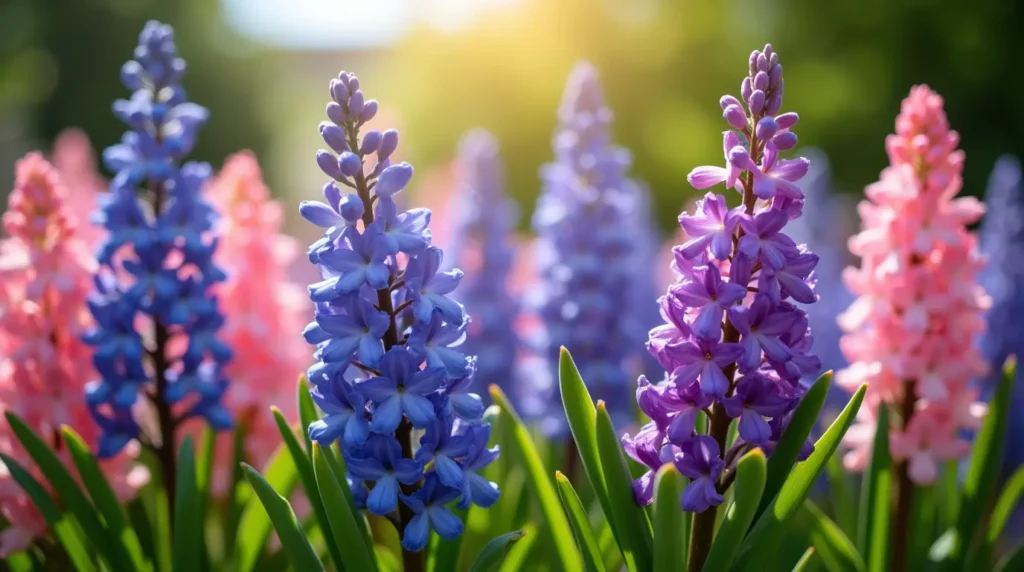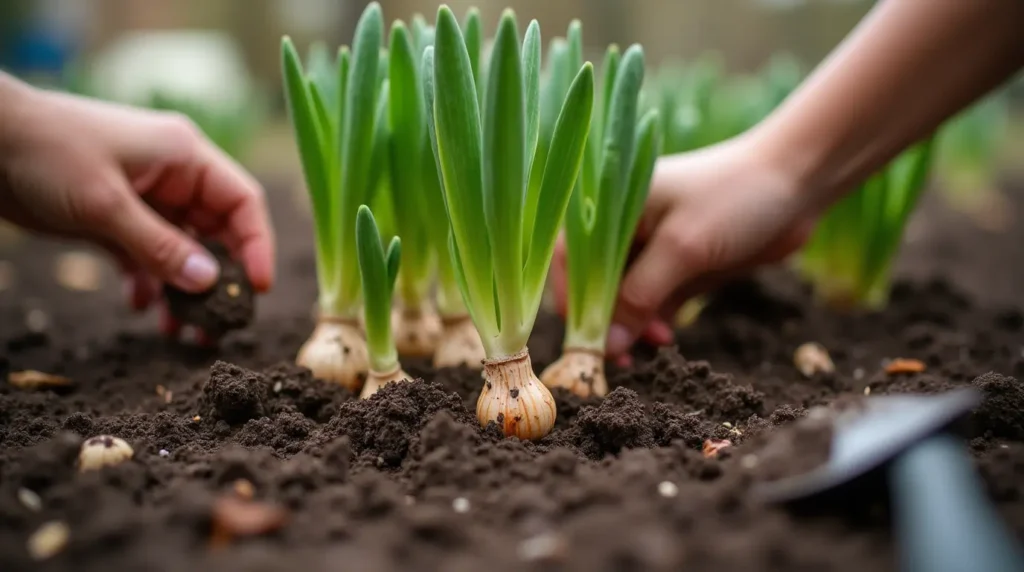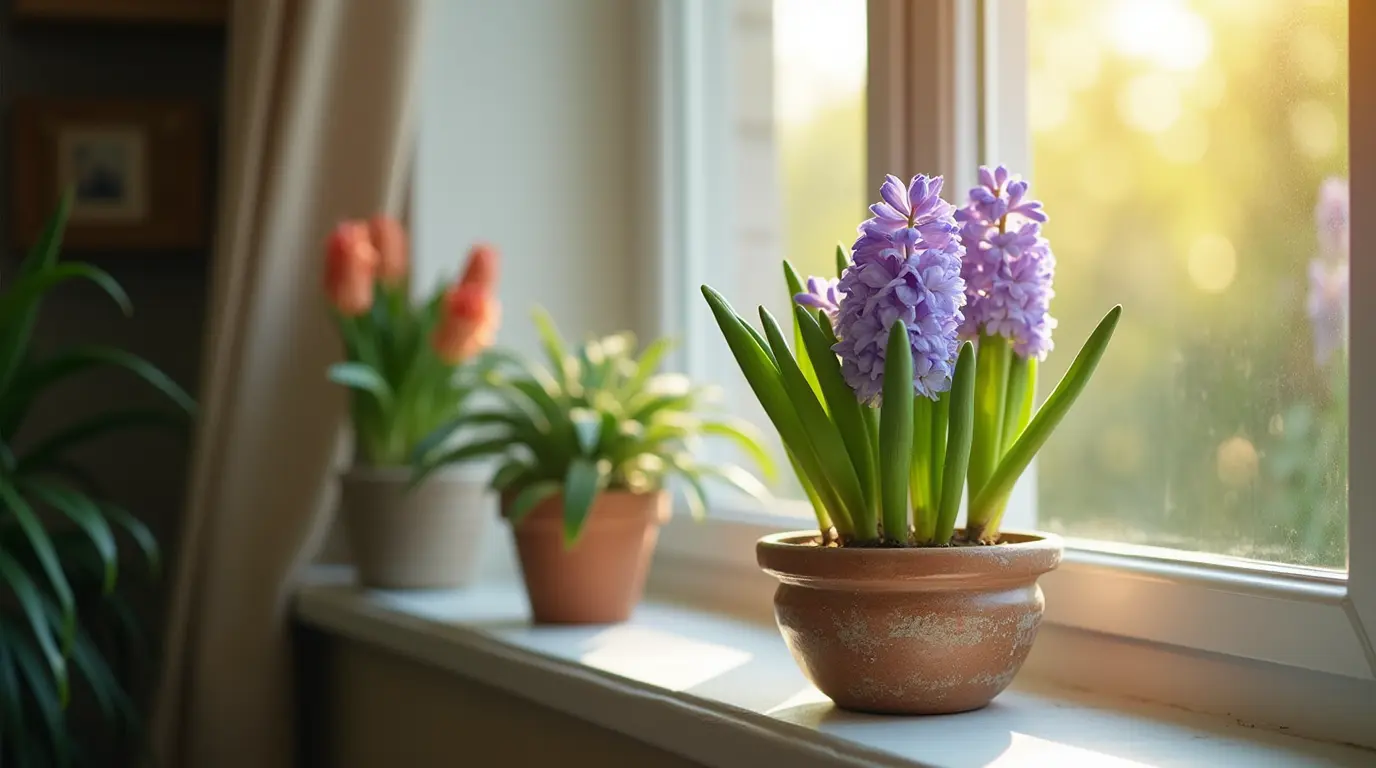Table of Contents
The hyacinth flower is a true delight for gardeners and nature lovers. Its vibrant colors, bell-shaped blooms, and enchanting fragrance make it a standout. This guide will teach you how to grow and care for these beautiful bulbs in your garden or indoors.
Key Takeaways
- Discover the history and significance of hyacinth flowers in gardens
- Explore the diverse range of hyacinth varieties and their unique features
- Learn about the optimal growing conditions for healthy hyacinth plants
- Understand the proper planting and propagation techniques for hyacinths
- Gain insights into essential care and maintenance practices for thriving hyacinth blooms
- Discover tips for growing hyacinths indoors and managing common problems
- Explore a seasonal care and maintenance schedule to ensure year-round success
Introduction to the Enchanting World of Hyacinth Flowers

Step into the captivating realm of hyacinth flowers. These plants have fascinated gardeners and nature lovers for centuries. Their vibrant colors and sweet scent make them a favorite in gardens and bouquets around the world.
Brief History and Origins
The hyacinth plant, known scientifically as Hyacinthus, comes from the Mediterranean. Ancient Greeks and Romans linked it to the story of Hyacinthus. Today, people grow these flowers everywhere, enjoying their many colors and shapes.
Popular Hyacinth Varieties
There are many hyacinth flower types, like Hyacinthus orientalis and ‘Blue Jacket’. Each one has its own special beauty. You can find soft pastels in ‘Delft Blue’ or bright colors in ‘Gipsy Queen’.
The Significance of Hyacinth in Gardens
- The hyacinth symbolizes rebirth, renewal, and good fortune. It adds elegance and charm to any garden.
- These flowers grow well in many climates and soils. They’re great for both formal and casual gardens.
- They’re also loved for cut flower arrangements. Their fragrance and beauty make them a top choice for bouquets.
Dive into the world of hyacinth flowers. Their history, variety, and symbolism offer a magical gardening experience.
Understanding Hyacinth Flower Types and Colors
Hyacinth flowers are a stunning mix of types and colors. They offer gardeners a wide range to choose from. You can find everything from the delicate pink hyacinth to the majestic purple hyacinth flower and the bold blue hyacinth.
The Dutch hyacinth is a favorite for its dense, spike-like blooms. They come in many colors, like the soft pink hyacinth and the deep purple hyacinth flower. You’ll also see the vibrant blue hyacinth.
The Roman hyacinth is another favorite. It has smaller, more delicate blooms in various colors. You can find them in white, lavender, and even yellow. These flowers are perfect for fragrant bouquets and arrangements.
- Vibrant blue hyacinth varieties
- Elegant purple hyacinth flower shades
- Soft and romantic pink hyacinth hues
- Delicate Roman hyacinth flowers in pastel tones
Whether you love the grand Dutch hyacinth or the gentle Roman variety, there’s a color for everyone. Hyacinth flowers add beauty to any garden or floral display. By knowing the special traits of each type, gardeners can create stunning displays that showcase the beauty of these spring-blooming bulbs.
Optimal Growing Conditions for Hyacinth Plants
To grow vibrant and healthy hyacinth plants, knowing their best growing conditions is key. This includes the right soil, light, and water. Let’s explore these important factors for successful garden hyacinths.
Soil Requirements
Hyacinth plants do well in soil that drains well and is rich in nutrients. The best soil mix has organic matter like compost and a sandy or loamy texture. This mix helps the hyacinth plant get the nutrients it needs and prevents water from pooling.
Temperature and Climate Needs
The garden hyacinth loves cooler weather and does best in temperate climates. They grow best in temperatures between 60-70°F (15-21°C). They also need a cold period, below 45°F (7°C), to develop bulbs and bloom.
Light and Water Requirements
- Sunlight: Hyacinths need at least 6 hours of direct sunlight a day. They can also handle partial shade.
- Water: Hyacinths need consistent moisture but shouldn’t sit in water. Water them regularly to keep the soil moist but not soggy.
By providing the right growing conditions, gardeners can make their hyacinth flowers bloom beautifully. This turns their gardens into magical places.
Planting and Propagation Methods

Hyacinth plants are a joy to grow. With the right techniques, you can enjoy these fragrant flowers year after year. This guide will help you plant and propagate hyacinth flowers successfully.
Timing is crucial when planting hyacinth plants. The best time is in the fall, from September to November, based on your climate. Plant the bulbs 4-6 inches deep, spaced 6-8 inches apart. This helps the roots grow before winter and ensures a beautiful spring bloom.
If you want more hyacinth flowers, try propagation. Division is a common method. In late summer or early fall, dig up the plants and separate the bulbs. Replant them at the same depth and spacing, making sure each has a healthy eye or shoot.
Another way is to grow hyacinth plants from seed. This method is slower but can lead to new varieties. Collect seeds from spent flowers in late fall or early spring. Follow the planting instructions for your area and conditions.
Learning to plant and propagate hyacinth plants will make your garden vibrant. With care, your hyacinth flower garden will flourish for years.
Essential Care Tips for Healthy Hyacinth Growth
To keep your hyacinth plant healthy, you need to care for it well. This includes knowing when to water and how to fertilize. Let’s explore the key tips for your hyacinth plants to grow well.
Watering Schedule
Hyacinths like moist soil but don’t want too much water. The goal is to keep the soil just right, not too wet. Water your garden hyacinth when the top inch of soil feels dry. Change how often you water based on your area’s weather.
Fertilization Guidelines
Hyacinths need a lot of food to grow well. Use a balanced fertilizer every two to three weeks when they’re growing. You can also use slow-release fertilizer at the start of the season. Always follow the fertilizer’s instructions to avoid harming your plants.
Pest and Disease Management
- Watch out for pests like aphids, spider mites, and thrips on your hyacinth plants. Treat them fast with insecticidal soap or neem oil.
- Diseases like botrytis blight, root rot, and fungi can harm hyacinths. Make sure air moves well around them and deal with problems quickly to stop disease spread.
- Always throw away sick plant parts and avoid watering from above to lower disease risk.
| Care Tip | Recommendation |
| Watering | Keep soil evenly moist, adjust frequency based on climate |
| Fertilization | Apply balanced, water-soluble fertilizer every 2-3 weeks during growing season |
| Pest Management | Treat aphids, spider mites, and thrips with insecticidal soap or neem oil |
| Disease Prevention | Maintain good air circulation, address issues quickly to prevent spread |
By following these care tips, your hyacinth plants will flourish. They’ll add beauty and fragrance to your garden for many years.
Indoor Growing Guide for Hyacinth Flowers
Bring the captivating beauty of hyacinth flowers into your home year-round with this comprehensive indoor growing guide. Hyacinth plants are not only enchanting, but they also thrive when cultivated indoors. This lets you enjoy their vibrant colors and heavenly fragrance even during the colder months.
Selecting the Right Containers
When growing hyacinth flowers indoors, choose well-draining containers that are at least 6 inches deep. Opt for sturdy, decorative pots or vases that complement your home’s decor. Clear glass containers are great to showcase the bulb’s growth process.
Planting and Forcing Bulbs
- Plant hyacinth bulbs pointy-side up, spacing them about 4 inches apart.
- For forced blooms, pre-chill the bulbs in the refrigerator for 8-12 weeks before planting.
- Cover the bulbs with 2-3 inches of well-draining potting mix.
- Water the soil thoroughly and place the container in a cool, dark location until the shoots emerge.
Maintaining Optimal Conditions
Once the hyacinth plants begin to grow, move the container to a sunny windowsill or under grow lights. Keep the temperature between 60-65°F. Also, keep the soil consistently moist, but not waterlogged.
Encouraging Longer-Lasting Blooms
To extend the flowering period, consider planting a succession of hyacinth bulbs every two to three weeks. This will create a staggered bloom time. It provides a steady supply of fragrant flowers throughout the winter season.
| Hyacinth Variety | Bloom Time | Fragrance Intensity | Preferred Light Conditions |
| Blue Jacket | Early Spring | Strong | Full Sun |
| Delft Blue | Mid-Spring | Moderate | Partial Shade |
| Pink Pearl | Late Spring | Intense | Full Sun |
Seasonal Care and Maintenance Schedule
Caring for hyacinth plants all year is key for their growth and beauty. Let’s look at the important tasks for each season to keep your garden hyacinth healthy.
Spring Care
When it gets warmer and your hyacinth plants start to grow, do these spring tasks:
- Take off any mulch or winter covers to let the plants get enough sunlight and warmth.
- Remove any dead or damaged leaves to help new growth.
- Use a balanced, slow-release fertilizer to feed the plants and help them bloom well.
- Watch for pests or diseases and fix any problems quickly to keep your hyacinth plants healthy.
Summer Maintenance
In the summer, your garden hyacinth needs these things:
- Keep the soil moist, watering when the top inch of soil feels dry.
- Remove spent flower spikes to help the plant grow more leaves and bulbs.
- Give a light, balanced liquid fertilizer every few weeks to keep growing.
- Check for pests or diseases and fix them fast to keep your hyacinth plants healthy.
Fall Preparation
As the seasons change, get your hyacinth plants ready for winter:
- Let the leaves die back and turn yellow before taking them off.
- Put a 2-4 inch layer of mulch around the plants to keep the soil warm and protect the bulbs.
- Think about dividing crowded hyacinth plants to help them grow better and bloom more next year.
Winter Protection
In the cold months, your garden hyacinth needs extra care to survive:
- Check the soil moisture and water if it’s too dry.
- Use a thick layer of mulch or straw to protect the bulbs from frost and freezing.
- Consider covering the plants with a breathable fabric or burlap to protect them from harsh winds and snow.
By following this care and maintenance plan, your hyacinth plants will thrive and bring you beautiful blooms every year.
Common Problems and Troubleshooting
Growing hyacinth flowers can be a joy, but sometimes, gardeners face challenges. One common problem is when the flowers don’t bloom well. This might be because of too little sunlight, not enough nutrients, or planting them too deep. To fix this, make sure your hyacinths get at least six hours of direct sunlight every day. Also, fertilize them with a balanced, slow-release fertilizer in early spring.
Another issue is when the leaves turn yellow or wilt. This could mean you’re watering too much, there’s a disease, or pests. Check your watering, look for pests, and use a fungicide if you think it’s a fungal infection.
Bulb rot is a serious problem that can kill your hyacinth plants. It happens because of bad drainage, too much water, or cold weather. Make sure your soil drains well and consider lifting the bulbs in summer. This helps them dry out and avoid rot.
FAQ
What are the different types and colors of hyacinth flowers?
Hyacinth flowers come in many colors like pink, purple, blue, white, and yellow. You can also find bicolored varieties. The most popular types include Dutch, Roman, and Grape hyacinths.
What are the ideal growing conditions for hyacinth plants?
Hyacinths love well-draining soil and full sun to partial shade. They need cold temperatures to grow well. Keeping the soil moist is key, especially when they’re growing.
How do I plant and propagate hyacinth bulbs?
Plant hyacinth bulbs in the fall, 6-8 inches deep and 6-8 inches apart. You can divide bulbs in the fall or let them self-seed. You can also separate offsets and replant them.
What are the common pests and diseases that affect hyacinth plants?
Hyacinths can face problems like bulb rot, fungal diseases, aphids, and thrips. Good drainage and pest monitoring can help prevent these issues.
Can hyacinths be grown indoors?
Yes, you can grow hyacinths indoors. Chill the bulbs to make them bloom earlier. Use containers with good drainage and control light, water, and temperature.
What is the significance and meaning of hyacinth flowers?
Hyacinth flowers have deep cultural and symbolic meanings. In Greek myths, they came from Hyacinthus’ blood. They symbolize constancy, sincerity, and sport, with colors representing various emotions.
How do I care for hyacinth plants throughout the seasons?
Caring for hyacinths through the seasons involves: – Spring: Cut off spent flowers, fertilize, and let foliage die back. – Summer: Lift and divide bulbs, and store them in a cool, dry place. – Fall: Plant new bulbs, and mulch to protect them. – Winter: Insulate and protect from freezing.

